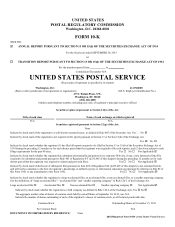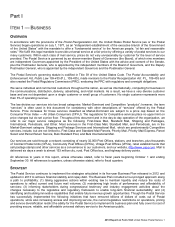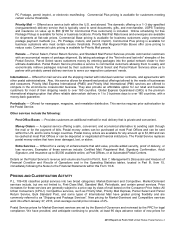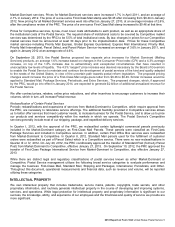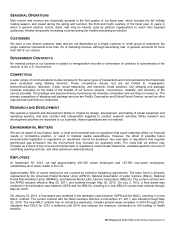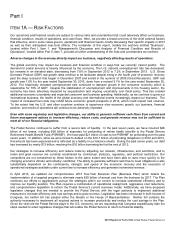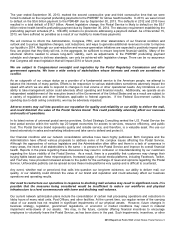US Postal Service 2013 Annual Report Download - page 10
Download and view the complete annual report
Please find page 10 of the 2013 US Postal Service annual report below. You can navigate through the pages in the report by either clicking on the pages listed below, or by using the keyword search tool below to find specific information within the annual report.2013 Report on Form 10-K United States Postal Service 8
Part I
ITEM 1A — RISK FACTORS
Our operations and financial results are subject to various risks and uncertainties that could adversely affect our business,
financial condition, results of operations, and cash flows. Here, we provide a broad overview of the chief external factors
that influence, and in some cases govern, operations and financial results, briefly discussing their specific impacts in 2013
as well as their anticipated near-term effects. The remainder of this report, notably the sections entitled “Business”,
located within Part I, Item 1, and “Management's Discussion and Analysis of Financial Condition and Results of
Operations”, located within Part II, Item 7, provides a further understanding of the risks and uncertainties we confront.
Adverse changes in the economy directly impact our business, negatively affecting results of operations.
The global economy may impact our business and financial condition in ways that we currently cannot predict. The
demand for postal services is heavily influenced by the economy. The U.S. national unemployment rate has decreased,
but remains in an elevated state, decreasing from 7.8% in September 2012 to 7.2% in September 2013. U.S. Gross
Domestic Product (GDP) real growth rates continue to be lackluster despite being in the fourth year of economic recovery
past the deep recession that began in December 2007 and ended in the summer of 2009 (Great Recession). GDP real
growth was 1.6% for the year ended September 30, 2013, down from a revised 3.1% for the year ended September 30,
2012. The historically elevated unemployment rate continued to dampen growth in the consumer economy which is
responsible for 70% of GDP. Despite the stabilization of unemployment and improvements in the housing sector, the
economy has been adversely impacted by sequestration and ongoing uncertainty over fiscal policy. This has created
additional economic uncertainty and impacted consumer and business spending. Additionally, as we continue to grow our
international business, the health of the global economy and international events increasingly impact our business. The
impact of increased fuel costs may inhibit future economic growth prospects in 2014, which could impact mail volumes.
To the extent that the U.S. and other countries continue to experience slow economic growth, our business, financial
position, and results of operations will continue to be adversely impacted.
Even with some regulatory and legislative changes, our ability to generate sufficient cash flows from current and
future management actions to increase efficiency, reduce costs, and generate revenue may not be sufficient to
meet all of our financial obligations.
The Postal Service continues to suffer from a severe lack of liquidity. In the past seven years, we have incurred $46
billion of net losses, including $38 billion of expenses for prefunding of retiree health benefits to the Postal Service
Retirement Health Benefit Fund (PSRHBF). We have paid $21 billion of cash to the PSRHBF for prefunding over the past
seven years. In addition, while we were forced to default on the $16.7 billion of prefunding obligations in 2012 and 2013,
this amount has been expensed and is reflected as a liability in our balance sheets. During the past seven years, our debt
has increased by nearly $13 billion, reaching the $15 billion borrowing limit at the end of 2012.
Our strategies to increase efficiency and reduce costs by adjusting our network, infrastructure, and workforce, and to
retain and grow revenue are currently constrained by contractual, statutory, regulatory, and political restrictions. Our
competitors are not constrained by these factors to the same extent and have been able to react more quickly to the
changing economic climate and industry conditions. The ability to generate sufficient cash flow to meet obligations is also
substantially dependent on the continuance, strength, and speed of the economic recovery and the execution of
operational strategies available under current law to increase efficiency and generate incremental revenue.
In April 2013, we updated our comprehensive 2013 Five-Year Business Plan (Business Plan) which details the
implementation of a targeted program to eliminate nearly $20 billion of annual cost from the business by 2017. The Plan
continues our efforts to aggressively pursue the strategies within our control to increase operational efficiency and to
improve our liquidity position. The Plan requires a combination of operational realignment, aggressive cost reductions,
and comprehensive legislation to reform the Postal Service’s current business model. Additionally, we have proposed
legislative changes that are needed to provide the Postal Service with the legal authority to implement additional
measures to increase efficiency and cost savings and to grow revenue. Legislation has been introduced in both houses of
Congress, but neither bill has passed either the Senate or the House of Representatives. Neither bill contains the
authority necessary to implement all required actions to increase productivity and realize the cost savings in the Plan.
Given the vital role the Postal Service plays in the U.S. economy, we are requesting that Congress expeditiously take the
steps needed to enact legislative changes that will enable the Postal Service to return to financial stability.

